Dissidia 012 Plot Analysis FAQ
by Glenn, The Twilight Mexican April 5, 2011 0 comments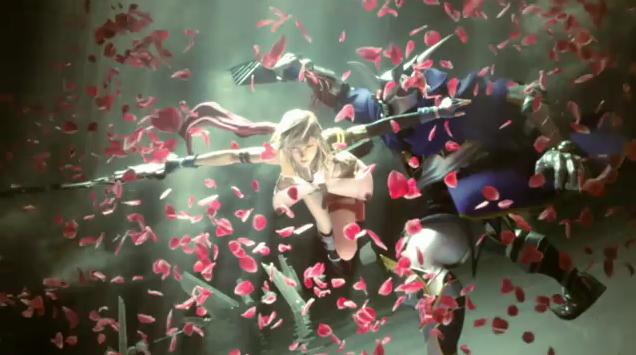
Mentioned in our “Dissidia 012 Review and Story Analysis” article, this is TheLifestream.net’s exclusive — and extensive — plot analysis FAQ of the Dissidia Final Fantasy series. This is the most comprehensive such analysis of Dissidia’s story around — the closest thing to a Dissidia FF Ultimania Omega you’ll ever find, unless Square Enix decides to do one, of course.
We hope that this article enhances your enjoyment and appreciation of Dissidia, and perhaps your understanding of it as well.
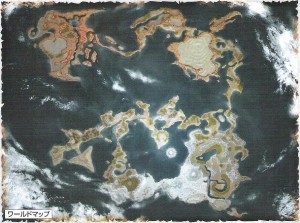
• What is the world that serves as the battleground for Dissidia?
What I often refer to as a Katamari ball of the various Final Fantasy worlds, the world in which the Dissidia conflict takes place is an amalgamation of the worlds of the first 13 main Final Fantasy titles, with the World B version of the first FF’s world serving as the base template into which everything else is placed.
Its status as such is confirmed twice during the Shade Impulse portion of the first Dissidia. First, in a conversation between the Emperor and Golbez from Shade Impulse cutscene 14 (Golbez: “This world is formed of shards brought from different realms by the two gods”); second, in a conversation between Sephiroth and Garland during SI Chapter 3-2 (Garland: “… This world is composed of elements collected from different realms”).
An apparent consequence of this shattering of worlds and realms is that all their inhabitants — with the exception of Chaos and Cosmos’s chosen warriors — are but disembodied consciousnesses in the realm of Dissidia; lost souls drifting around the world.
In Chaos Report 5 from the first Dissidia, Cid of the Lufaine mentions trying to give physical form to some of these spirits:
While observing how they acquired pawns to
fight in their conflict, I found that a great
number of the consciousnesses had drifted to
this world from other dimensions.
I wondered if I might be able to give those
consciousnesses physical form. After countless
experiments, finally my testing reached success.
The failures were sealed in the Interdimensional
Rift.”
Reports 15 and 16 from Dissidia 012 elaborate on this matter, explaining that Cid of the Lufaine also attempted to use his own memories as the basis for a new life form. He was only successful in creating one such being, however, and from his own memories only:
“Attempts at embedding my own memories to
manikins fail.
Like the ‘failures’ of my old experiments,
they do not retain human likeness.
No complete memory transplant could be done.”
(From Report 16)
“Memory successfully embedded in experiment.
Confirmed non-crystallization of body.
Difficult to sense any will in its eyes,
perhaps caused by incomplete transplant.”
Read on for more about Cid’s work and its consequences.
• Were the shattered worlds ever restored?
The various worlds included in the battle world’s composition were restored to their proper places when the cycles of conflict were brought to an end, per Golbez’s remarks in Shade Impulse scene 14: “As long as Chaos reigns, the shards are fated to sink into endless darkness. But if Chaos perishes, the shards would be released, returning to where they once were.”
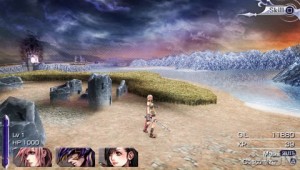
The Warriors of Light must have asked Laguna for directions to Cornelia here. Better late than never?
• What are Worlds A & B?
Mentioned at the beginning of all of the Reports is a location designated either World A, World B, or both. Presumably the world to which the events detailed therein apply, what are these in reference to?
While the game never spells the point out directly, World A is the world of the first Final Fantasy, from which Cid of the Lufaine hails. World B is the world discovered on the other side of a gateway to the Interdimensional Rift by Lufenian scientists — a world in ruins, but one which bears the same world map as World A.
World B is the version of this planet that serves as the basis for the conflict of the gods seen in Dissidia.
Whether they are different time periods of the same world, or different dimensions’ incarnations of the same world, is unclear.
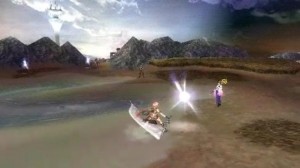
• What are the orbs of light on the world map?
In all likelihood, these orbs are the spirits/disembodied consciousnesses of the unfortunate denizens of all the realms that were sundered by the circumstances of the war. Notice that the first of every four orbs broken and absorbed carries the message “A frail power of the dead dwells.”
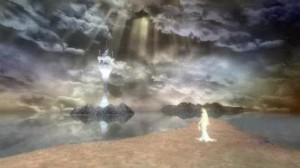
• What is that white tower on the world map?
That’s Order’s Sanctuary. It’s Cosmos’s place.
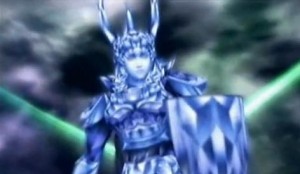
• What are the manikins?
Reports 8, 9 and 10 speak of a mysterious form of life with the appearance of a crystal ore. It changes form in reaction to the appearances of nearby life forms, but has no discernible will of its own.
The ore was discovered by Lufenian scientists who sent investigation teams to World B through a gateway to the Interdimensional Rift. They used this ore for many experiments in which they attempted to produce artificial life, and named these simulated life forms manikins.
They still demonstrated no will of their own, however, and so the scientists attempted to grant them consciousnesses via imbuing them with transplanted memories.
In almost all cases, these experiments failed to produce the intended results.
As detailed in Chaos Report 5 from the first Dissidia, as well as Reports 15 and 16 from Dissidia 012, Cid later attempted to create more perfect manikins, but only succeeded in creating one — and from his own memories. All his failed experiments were sealed in the Interdimensional Rift and would later be discovered by Exdeath, according to his in-game Museum profile, to become the army utilized by the warriors of Chaos in cycle 012:
• What is this “crystal ore” used to create manikins?
After the release of the first Dissidia, a number of fans noted the similar appearances of the manikins to the random encounter enemies fought by Zidane and his crew in Crystal World, the final dungeon of Final Fantasy IX. Those enemies, weaker simulacrums of the 4 Chaoses from FFIX, also behave in similar manner to the manikins in that they display no consciousness, despite those whom they imitate very much possessing intellect.
It may well be that the crystal ore discovered by the Lufenian scientists is either material from Crystal World, or at least something very much like it, such that it imitates the appearances of others the way the ore in Crystal World did after Kuja resurrected the 4 Chaoses there.
At the very least, we know there is some strong association between memories, crystals and life given their repeating, interrelated appearances in such Final Fantasy titles as FFVII, IX and X/X-2, as well as the “Source of Power” article on pg. 8 of the Final Fantasy 20th Anniversary Ultimania File 2: Scenario guide. If the graph under “Circle of Life” on that page is any indication, it seems that planets with Lifestreams — which grow from the accumulation of memory — have crystals at their cores.
Given that Cid and the other Lufenian scientists were successful in producing genuine life — Chaos, Cosmos and the Warrior of Light — from inserting memories into the crystal-like ore that so resembles that of the material composing Crystal World, it may not be a stretch to surmise that the first living creatures were produced in a similar way given that there was no other physical material present in Crystal World.
• Who is the Great Will?
In a metatextual capacity, the player is identified as the Great Will at the end of Inward Chaos from the first game.
As far as the story itself goes, however, Cid of the Lufaine is identified as the Great Will in the Chaos Reports, specifically Chaos Report 10. Earlier hints to his identity came from Garland telling Chaos that he had guided him “in accordance to the Great Will’s wish,” since Cid mentions in Chaos Report 4 that he’d gotten Garland to agree to “stand at the right hand of discord.”
As well, both Shinryu’s profile in the first Dissidia’s Museum and Shinryu’s brief dialogue with Chaos near the end of Shade Impulse make it clear that he had been assigned a task by the Great Will. In Chaos Report 3, Cid mentions that he’d made a pact with “a certain dragon wandering through space and time”; this dragon, of course, was Shinryu.
For its part, Dissidia 012 outright refers to Cid of the Lufaine as the Great Will in his in-game profile under the Museum, and Cosmos addresses him as such in the cutscene from Report 20 (Japanese version only):
あなたも自分の道を歩んでください
さようなら シド.
(In the official English translation, Cosmos’s use of “Great Will” is replaced with “my divine creator.”)
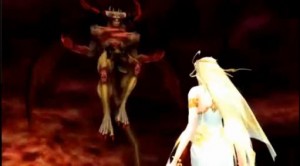
• What are Chaos & Cosmos?
KOS-MOS is a powerful, armored gynoid, developed by the interstellar conglomerate Vector Industries, while chaos is the failsafe of the universe, the human incarnation of the power of Anima.
… Wait, wrong game.
[Note: The following information in this and the next question’s response either come straight from or are a synthesis of information in the Cosmos Reports, Chaos Reports, Shade Impulse, Inward Chaos storyline and Secret Ending of the first Dissidia, and the Museum Character Files, text-only portions of the Reports and Confessions of the Creator elements of Dissidia 012]
Chaos is both an anthropomorphic entity embodying the concept of discord, and a successful manikin created by Cid of the Lufaine and scientists of the Onrac nation from the memories of 10 or more unidentified individuals.
Who these people were or whether they were unusual in any way is unknown, though it is known that they were executed afterward for confidentiality purposes.
Cosmos, meanwhile, is both an anthropomorphic cosmic entity embodying harmony, and a successful manikin created by Onrac scientists from the memories of the manikin that would become Chaos.
Following his creation by the Onrac scientists, the military recognized Chaos’s magnificent magic potential and intended to use him as a weapon to defend itself from other nations, one of which commanded summon creatures as well as the robot Omega from Final Fantasy V. While preparing him for his introduction to the battlefield, Chaos — who had a beastly but nonetheless childlike form — was raised by Cid and his wife.
For reasons I will elaborate upon a couple of responses further down in this Q&A, Chaos had no interest in destroying anything unnecessarily, so once the military called upon him, they ordered Cid’s wife — whom the creature viewed as its mother — to command him to destroy the nation in command of the summons and Omega.
Despite its own immense power, Omega was banished to the Interdimensional Rift along with the summons, and the nation they served was reduced to what Report 2 calls “hell itself.”
Afterward, Cid’s wife was plagued by guilt and refused to be party to further violence. Consequently, she and Cid were locked up, branded traitors, and a new manikin was created — this one a similitude of Cid’s wife, formed with Chaos’s memories of her as the basis. They named this clone Cosmos.
• How did the war of Dissidia begin?
Not long after their imprisonment by the Onrac military (covered in the previous response of this Q&A), Cid and his wife learned of the similitude’s existence and the military’s intention to use her as a means of controlling Chaos. Unwilling to allow this, they escaped from their prison and infiltrated the lab where Chaos and Cosmos were being kept.
As they prepared to escape with Chaos, a guard shot Cid’s wife, injuring her. Seeing his mother so wounded, Chaos was filled with rage and lashed out with the power of discord, opening a gate to the Interdimensional Rift in the process. The facility was destroyed, and Cid, Chaos and Cosmos were all lost to the Rift.
Some time later, they encountered Garland, as well as the cosmic dragon Shinryu, a traveler of time and space via the Rift.
Seeking revenge against the Onrac military, Cid entered into a bargain with Shinryu: Cosmos and Chaos would be pitted against one another in war, utilizing pawns summoned from many worlds. As the pawns battled, they would accumulate experiences — memories — that would then be harvested by Shinryu once one side had lost. The condition of losing would be met when either all warriors on one side died or their respective deity was felled.
Shinryu would then reset the pieces on the board, reviving whichever god had died along with any dead warriors on either side.
After absorbing the memories of the combatants to gain more power, Shinryu would share some of the newly accumulated power with Chaos, and, thus, both would become more powerful with each cycle. In this way, Shinryu received payment for his involvement in Cid’s war.
In addition, Cid asked that Shinryu give him immortality by taking his body and allowing him to reside in the realm as a disembodied consciousness observing all developments of the war.
Though Chaos initially had no interest in fighting against Cosmos, as she was his mother’s clone, Cid was able to get Garland to convince him to fight. Garland was also the one to give Chaos his name, which he did at this time.

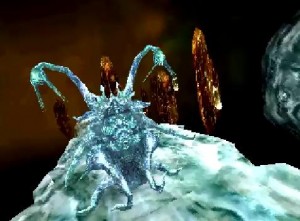


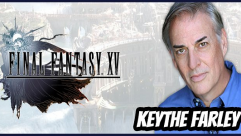

No comments yet
Log in or Register
Is Dissidia 012’s Scenario 013 Light to All is the same as the first Dissidia’s Destiny Odyssey?
(Hope the log-in still works on this thing… You probably know who I am already but as a little give away: I’m doing research on a character analysis of Kuja for day 14 of the FF meme and I could use some help)
First off, a long round of applause for your efforts in compling this. I’ve read it quite a few times before but have yet to comment on it. However it is proving to be a godsend for helping me understand Dissidia’s world (I’m still struggling through 000 very slowly) as I try to put everything in perspective for my analysis, so for that many thanks.
As much as I want to theorize on these other little factoids and choice morsels, I’m going to have to be entirely Kuja-centric in my questions and debates. So here goes:
(1) You theorize that Kuja may have been a Cosmos warrior before 012 and was spirited away in the same manner that Jecht and presumably Goblez were. Is there any difinitive information provided other than Garland’s quote in the revised version:
“Not at all. You and I are the same–warriors summoned to this land by the god of discord. And that is the truth for all of us. Even that witch, Ultimecia… Not one remembers everything. You were used when you had just awakened.”
Could this be taken to suggest that he was referring to Kuja’s first cycle as opposed to 013? Even though the line refers to them both as being summoned by Chaos? Either way I’m confused.
(2) What exactly prompted Kuja’s memories to return? Was it the defeat of Cosmos or alternatively him facing against Zidane in Destiny Odyssey IX (since it’s been established that fighting someone from your world on the opposite side restores memories) and noticing things did not match up. I understand that S-E did not provide us with much info due to Kuja not being seen again until Shade Impulse when he’s ditched the 013 personality and is calm albeit melancholic and seems hardly antagonistic towards Zidane when they fight. Or is it that most of his memories have returned by that point and his final fight against Zidane brings the final ones back hence his throwing in the towel at his defeat? What I’m trying to determine is if he remembered 012 or not since Shinryu should’ve consumed those memories but since Sephiroth has proved capable of remembering 012…well I’m scratching my head on that one. (Sorry, I’m asking you to answer questions that I don’t think have any concrete response but I’d like to hear your thoughts all the same)
I’m very curious about these false memories Kefka implanted in him and how exactly Kuja went from that OOC ball of bratty to what was effectively the closest thing we got to end of FFIX Kuja with a bit of his 012 personality mixed in. I believe that he was the only villain who was legitimately defeated by their rival in their respective destiny odyssey (considering how violently he reacts to his loss to Zidane as well as how he didn’t seem keen on co-operating with the plans of the other Chaos members I’m guessing he honestly played to win) but the transition from this vengeful “Never…when the curtain falls it is I who shall bask in the applause” to the resigned person he was the next time we saw him raises questions as to when and how his memories returned and which ones they were. What is obvious is that he no longer believes the false ones of hating Zidane; their exchange before their final fight “I see that you’re just as longwinded as ever.” “And I see that you never learn. What will you do when all has been lost?” seems almost good natured albeit mildly insulting.
The question is was it the removal of harmony from the world that caused his memories to return or did he regain memories of his redemption from FFIX that did not mesh with the false ones? I’m more inclined to pick the former since Kuja’s pull point is from the end of FFIX so he should’ve been revived as a good person again in 013 and not have forgotten Zidane coming to rescue him. Presumably whatever Kefka implanted in him made him either dismiss this as false or had Zidane betraying his trust afterwards.
These are my only two major issues that I need to try and work out, everything else seems to add up in my head. *gets back to work*
Hey, toffee! Sorry I haven’t been in touch lately. Been busy with life. I know how you know how that is, though. Thanks for all your compliments concerning my efforts on 012-related stuff, by the way, and I’m really glad they’ve been of help to you. =)
I really have to agree with all your sentiments regarding 012’s strengths and weaknesses (too many missed opportunities, eh?), by the way, as well as your interpretation of Kuja during cycle 013. I also think he was the only villain legitimately defeated by his nemesis during that cycle, and that he had recovered his real personality by the time of Shade Impulse. He seems much more good-natured at that point.
That being said, like you, I’m not sure what exactly causes his memories to return. My guess would be the loss of harmony, though, since we’re only shown that fighting others from one’s homeworld allows memories of the shared homeworld to return. Since, as you say, memories of previous cycles should have been devoured by Shinryu, I’d guess that those could only be restored with order being completely thrown out of whack with Cosmos’s death.
Let me know what you think. Good to hear from you. =)
Hey, I was wondering if you had a breakdown of which period of time from their game each character was summoned from?? Thanks!
Oh wow, you actually did update…sort of. Good to see that you recognized that Cosmos was the Clone of Cid’s wife, but you still maintain the “Katamari Ball of FF Worlds”? Even though Golbez’s statement is obviously untrue, because World B existed before that & it was noted that the Gates respond to memories? Also, while the point about the Portal being closed is true, the supporting point about it not being present during a cutscene is irrelevant–those could have taken place in 2 different Gates.
I will concede that my theory regarding the characters being Manikins was never (& never will be) proved beyond a reasonable doubt, but if you ask me, it’s a Hell of a lot better of an explanation than “all of these inconsistencies just don’t matter.” Also, it still doesn’t follow from the “it’s a Final Fantasy story” statement that this theory is untrue. For starters, very few FF stories carry characters from other titles over. Secondly, Dissidia includes Shinryu, Garland, Warrior of Light, & Cid as canon characters–they don’t ALL have to be. Other theories of mine, such as Kuja not inheriting his change of heart, I will admit were completely wrong.
This may be too late now for a comment regarding the Dissidia series, but I’ll comment anyway.
First of all, I thank you, and all collaborators, for this wonderful plot analysis. Ever since the release of Dissidia and its prequel, a lot of bashing regarding its story left me dumbfounded: do they not comprehend the story, or all they know are those presented graphically? Perhaps they may have little Final Fantasy background? No matter the reason, it just makes me sad it’s not as popular as it could be. Many times I tell people that it is intended to be more of the fighting game genre, and fighting games don’t usually have deep stories. Dissidia however, given time and willingness to participate, will present you a story so deep and thought wisely as to make even the now-cliche original Final Fantasy to be much more. I understand that the volume of games nowadays are too many and almost all produces a story that it’s hard to create a truly unique one, but I am pleased by Dissdia’s.
Now I have played this game long ago; I had it since release. However, new found desire to help SE prompted me to purchase the game again in digital format for my VITA, and then starting anew. Having deeper knowledge in Final Fantasy now than before (as I have only played VI, VII, and VIII by the original Dissidia, but have finished the rest except X onwards by the time Duodecim was released and even more so now that a few years have passed), it’s absolutely more enjoying. Ever since finishing the game a few years ago (by finished, I mean squeezing out every bit of story contained), I have hoped for a new Dissidia, but as of now, there is none still. With those things in mind, and the fact that I’ve never seen this analysis before, seeing this now really puts a warm smile on my face. I also learned a lot more about it than what I have previously compiled which was already enough before to make me say it has a good story. I agree on your other article that they should have presented the game in much more detail and shouldn’t have relied too much on text, as you’ve said there as well, a lot of those things only in text will have looked marvelous in action. Right now, however, the story is the focus, and again I will say, thank you for this great plot analysis.
I now know what to present to some of my entirely newcomer-to-Final-Fantasy friends regarding confusion about its story, and may they find that, other than its gameplay being absolutely satisfying, its story isn’t so simple as pitching random protagonists and villains together to fight for the player’s satisfaction.
In the end, cutting away from my enjoyment of elaboration regarding Dissidia, I’m quite pleased to see that this analysis is given careful detail despite the subject being fiction, much like my amusement in the explanation of The Matrix regarding cybernetics and its inconsistencies even when other confusing factors are ignored. People usually think that contemplating on something fictional is a waste of time, but of course, that’s what they think; it bears no significance on how we want to spend our time, and in turn, enjoying it. To see things not succumb to nihilism and people finding more ways to enjoy life other than the usual money, popularity and sex notions is simply pleasing to me. Makes the world a much more enjoyable place to live in.
For the last time, thanks again for this great plot analysis! I’ll be sharing this to my friends who are interested. Hoping for another Dissidia game!
The plans vegetables provide some carbohydrates, though the protein increases the meal stamina and suppressing of your appetite ability.
Many studies and individual experiences reveal that celebrity diets do not
work, what exactly does. Even further analysis brings forth just one more conclusion how the supply of benefits lies
inside the additional nutrients and vitamins that are consumed in raw foods, rather
than the enzymes or plants at all.